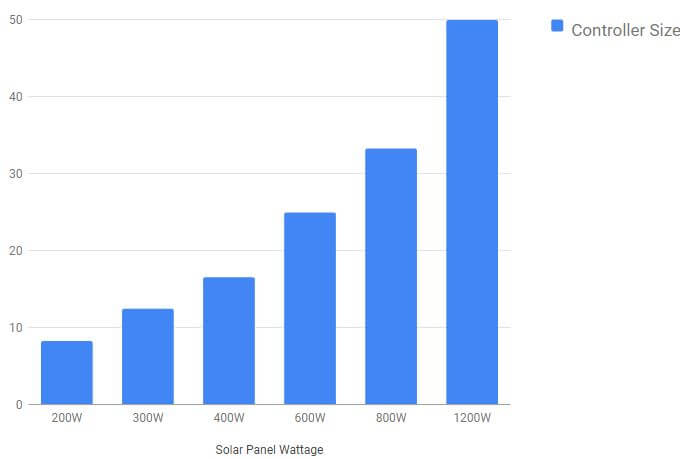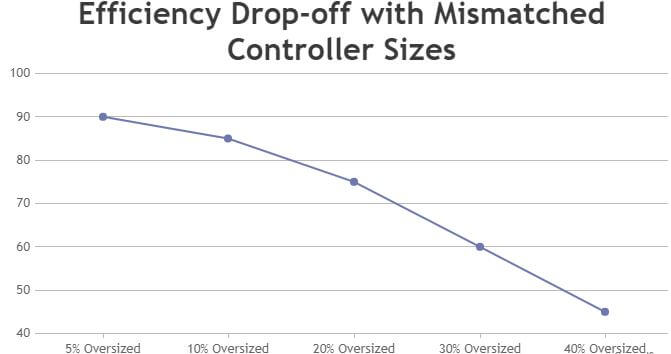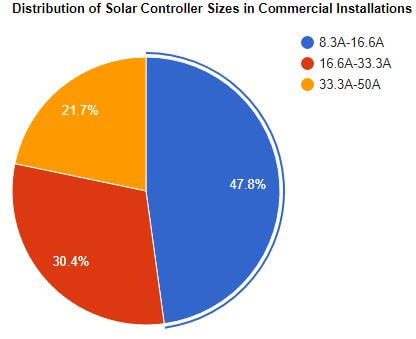To determine the size of the solar controller you need, divide the total watts of your solar array by the voltage of your battery bank. This calculation provides the output current of the charge controller.
Solar panels come in various wattages, and the size of the charge controller you need varies accordingly. For a 300W solar panel, using a 24V battery bank, you’d need a controller with an output current of 12.5A. Similarly, for a 200W panel, the required output current is 8.3A. As the wattage increases, so does the need for a higher-rated controller. For instance, a 1200W panel demands a 50A controller, while an 800W panel requires a 33.3A controller. Panels with wattages of 400W and 600W necessitate controllers with output currents of 16.6A and 25A, respectively.

There are tools available, like the solar charge controller sizing calculator, that can assist in making these calculations easier. By inputting the wattage of your solar panel and the voltage of your battery bank, these tools can quickly determine the appropriate size of the charge controller for your setup.
For a more in-depth analysis on this topic, we invite you to read the detailed article below.
Determining the Right Solar Controller Size for Your Needs
Basics of Solar Controller Sizing
What is a Solar Controller and Why Size Matters
Solar controllers, often known as charge controllers, play a pivotal role in solar power systems. They regulate the voltage and current from solar panels going to the battery, ensuring batteries don’t overcharge. Just like you wouldn’t wear shoes that are too big or too small, the size of your solar controller needs to be just right for your system. If it’s not the right size, you risk inefficiencies and potential damage to your batteries.
The Fundamental Formula for Sizing
The core principle behind sizing a solar controller is straightforward. You simply divide the total watts of your solar array by the voltage of your battery bank. This gives you the output current of the charge controller. Let’s say you have a 1000W solar array and a 24V battery bank. Doing the math, you’d get an output current of 41.6A. So, you’d ideally want a charge controller rated at least 40A.
Factors Influencing Solar Controller Size
Battery Bank Voltage Variations
Battery bank voltage isn’t a one-size-fits-all scenario. Common voltages include 12V, 24V, and 48V. The voltage you choose can influence the size of the solar controller you need. Higher voltages often mean you can manage with a smaller controller, but it’s essential to do the math to be sure.
Solar Panel Wattage and Its Impact
Solar panels come in a variety of wattages. From small 100W panels suitable for basic needs to massive 1200W panels for larger installations, the wattage directly impacts the size of the controller you’ll need. Larger wattage means more power, and thus, a bigger controller to handle that power.
Environmental Factors and Efficiency Considerations
The environment where you set up your solar system can also influence the size of your controller. In areas with more sunlight, your panels might produce power more consistently, affecting the charge controller’s workload. Moreover, the efficiency of your panels and the age of your batteries can also play a role in determining the right controller size.
Common Solar Panel Wattages and Corresponding Controller Sizes
Different solar panels produce varying amounts of power. Here’s a breakdown of some common wattages and the corresponding controller sizes you’d need:
| Solar Panel Wattage | Recommended Controller Size (for 24V battery) |
| 200W | 8.3A |
| 300W | 12.5A |
| 400W | 16.6A |
| 600W | 25A |
| 800W | 33.3A |
| 1200W | 50A |
Visualizing Solar Controller Sizing
Popular Solar Panel Wattages and Their Ideal Controller Sizes

Efficiency Drop-off with Mismatched Controller Sizes
Imagine a scenario where the solar controller isn’t appropriately sized. The efficiency of the system can drop significantly. This line chart showcases how efficiency can taper off with mismatched controller sizes.

Advanced Considerations in Solar Controller Sizing
Impact of Multiple Solar Panels in an Array
Having multiple solar panels in an array can complicate the sizing process. If you’re connecting panels in series, the voltage adds up, but the current remains the same. In contrast, connecting in parallel keeps the voltage constant while the current adds up. Knowing how you’ll connect your panels is crucial to get the sizing right.
Adjustments for Future Solar System Expansion
Planning to expand your solar system in the future? It’s wise to consider this when sizing your solar controller. If you anticipate adding more panels or increasing your battery bank’s voltage, you might want to opt for a larger controller now to accommodate future growth.
Tools to Simplify the Sizing Process
Calculator: Input Your Panel Wattage and Battery Voltage for Instant Results
Real-world Examples and Case Studies
Residential Solar Setups and Their Controller Choices
Many homeowners are turning to solar energy to reduce their electricity bills. In a typical residential setup, you might find solar panels ranging from 200W to 800W. Based on our earlier discussions, these setups would require controllers ranging from 8.3A to 33.3A. It’s always intriguing to see how theory translates into real-world applications, isn’t it?
Distribution of Solar Controller Sizes in Commercial Installations

FAQs
Which All-in-One Solar Charge Controller Inverter is Best for My Needs?
When it comes to improvements in solar power, finding the best all-in-one solar charge controller inverter for your needs is crucial. Factors like power output, compatibility with solar panels, and battery capacity are key considerations. Research reputable brands, compare specifications, and read customer reviews to make an informed decision. Consider seeking professional advice for integrated solutions to optimize your solar power system.
What’s the Role of a Solar Controller in a Solar System?
A solar controller, often referred to as a charge controller, acts as a gatekeeper between the solar panels and the batteries. Its primary role is to regulate the voltage and current coming from the solar panels. This ensures that the batteries don’t get overcharged during the day when sunlight is abundant and don’t get discharged at night or on cloudy days. By doing so, it maintains the health and longevity of the batteries, ensuring they have a longer life and operate efficiently.
Why Can’t I Just Connect My Solar Panels Directly to My Batteries?
Connecting solar panels directly to batteries without a controller can lead to several issues. The most significant problem is the risk of overcharging the batteries. When batteries get overcharged, they can overheat, which might lead to reduced battery life or even potential hazards like fires. A solar controller prevents this by ensuring only the required amount of power reaches the batteries.
How Does Panel Efficiency Impact Controller Size?
Panel efficiency refers to how well a solar panel can convert sunlight into electricity. Higher efficiency panels can produce more power in the same amount of space. If you have a highly efficient panel, it might produce more power than a larger, less efficient panel. This means you might need a larger controller for a smaller but more efficient panel. Always check the power output and not just the size when sizing your controller.
Can I Use Multiple Controllers for a Single Solar System?
Yes, you can use multiple controllers in a single solar system. This setup is often seen in larger installations where the power output is too much for a single controller to handle. In such cases, the solar array is divided, and each section is connected to its own controller. This ensures that each controller handles a manageable amount of power, optimizing the system’s efficiency.
What Happens If My Solar Controller Is Too Small?
If your solar controller is too small for your setup, it won’t be able to handle the power coming from the solar panels. This can lead to the controller overheating or failing. Additionally, it might not charge the batteries efficiently, leading to reduced battery life. It’s always better to choose a controller that’s slightly larger than what you think you’ll need to account for any future expansions or unexpected power surges.
Do I Need to Replace My Controller If I Add More Panels?
Not necessarily. If you initially chose a controller that’s larger than your current needs, you might be able to add more panels without replacing it. However, if adding more panels means the power output exceeds the controller’s capacity, then you’ll need to upgrade to a larger controller or add an additional one to handle the extra power.
How Do Weather Conditions Affect My Solar Controller Size Choice?
Weather conditions, especially sunlight availability, can influence the power output of your solar panels. In areas with consistent, strong sunlight, panels might produce power at their maximum capacity regularly. In contrast, in cloudier regions, the power output might be less consistent. While the weather doesn’t directly impact the size of the controller you need, it can influence the efficiency and power output of your panels, which in turn affects the controller size. Always consider local weather patterns when planning your solar installation.
Choosing the right solar controller size is more than just a numbers game. It’s about ensuring efficiency, longevity, and optimal performance of your solar system. By understanding the basics, considering various factors, and using tools and visual aids, you can confidently select the best controller for your needs. And as solar energy continues to grow in popularity, being informed will help you make the most of this sustainable energy source.
